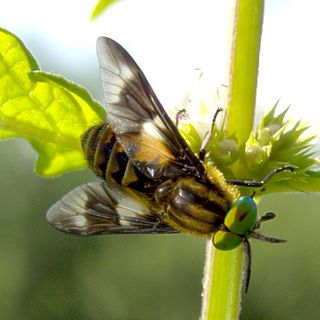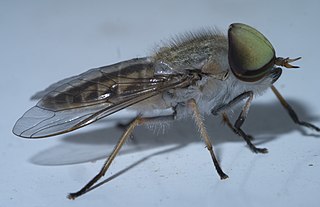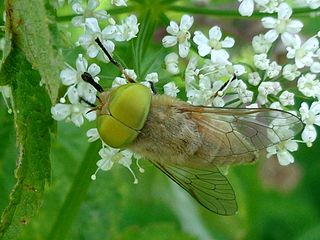
Superfamily Tabanoidea are insects in the order Diptera.
Tabanus fusconervosus is a horse fly in the subfamily Tabaninae, in the order Diptera ("flies").

Tabaninae is a subfamily in the family Tabanidae commonly known as horse flies. There are more than 3000 described species in Tabaninae.

Leucotabanus is a genus of horse flies in the family Tabanidae.

Tabanini is a tribe of horse and deer flies in the family Tabanidae. There are at least 220 described species in Tabanini.

Tabanus proximus is a species of horse flies in the family Tabanidae.

Atylotus is a genus of horse flies in the family Tabanidae.

Chrysopsinae is an insect subfamily in the family Tabanidae commonly known as deer flies or sheep flies and are bloodsucking insects considered pests to humans and cattle. They are large flies with large brightly-coloured compound eyes, and large clear wings with dark bands. They are larger than the common housefly and smaller than the horse-fly.
Chrysops divisus is a species of deer fly in the family Tabanidae.
Hamatabanus is a genus of horse flies in the family Tabanidae.
Hybomitra frontalis is a species of horse flies in the family Tabanidae.
Hybomitra captonis is a species of horse flies in the family Tabanidae.
Chrysops furcatus is a species of deer fly in the family Tabanidae.
Hybomitra affinis is a species of horse flies in the family Tabanidae.

Tabanus quinquevittatus is a species of horse fly in the family Tabanidae.

Hybomitra lasiophthalma is a species of horse flies in the family Tabanidae.
Chrysops aestuans is a species of deer fly in the family Tabanidae.
Acanthocera is a genus of flies belonging to the family Tabanidae.
Hybomitra zonalis is a species of horse flies in the family Tabanidae.

Sphecodemyia is a genus of flies in the family Tabanidae.










